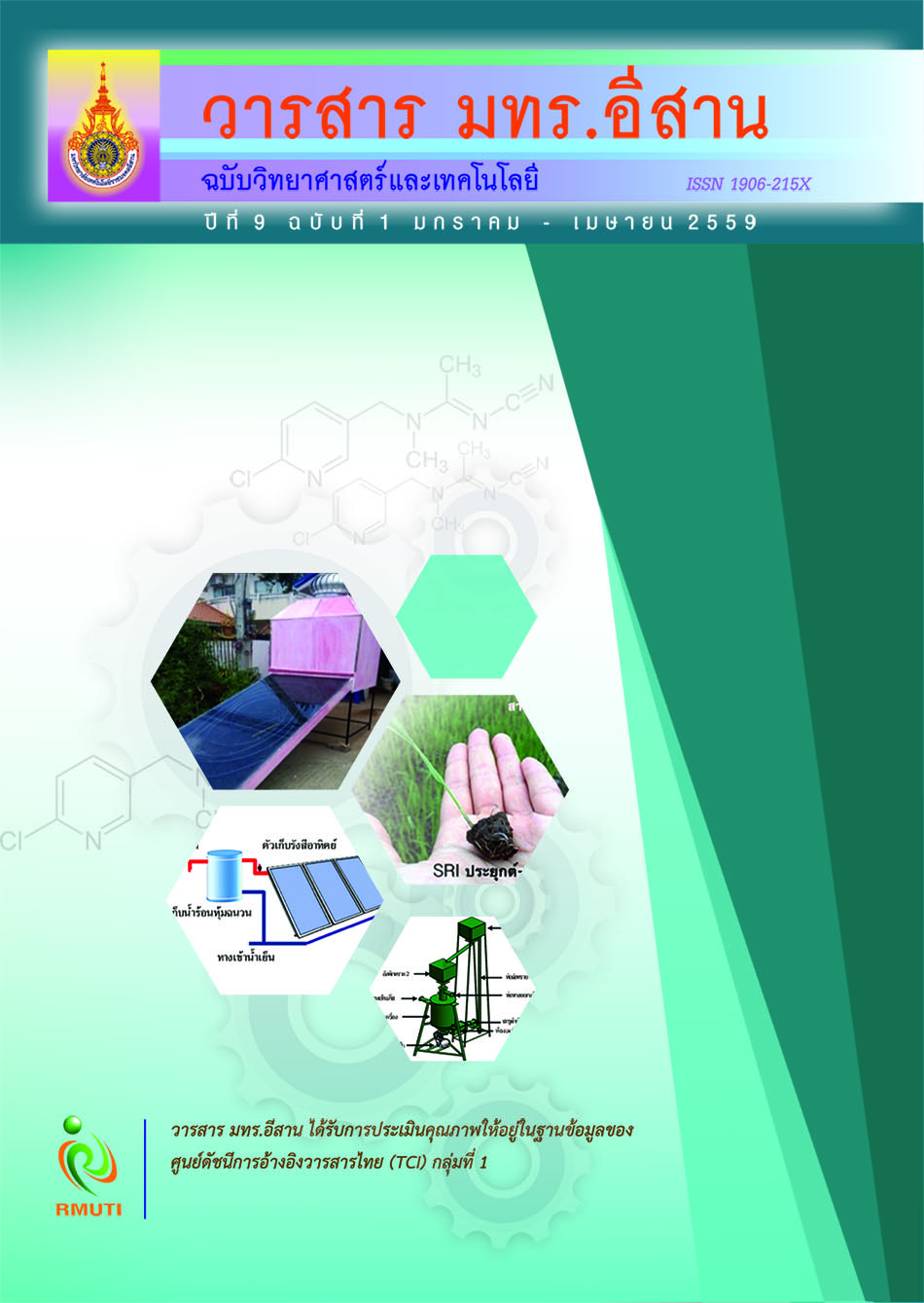ตัวควบคุมพีไอที่เหมาะสมโดยใช้วิธีการจีเนติกสำหรับดี-สแตดคอม (Optimal PI Controller using Genetic Algorithm for D-STATCOM)
Main Article Content
บทคัดย่อ
บทคัดย่อ
บทความนี้นำเสนอแบบจำลองและการออกแบบตัวควบคุมของอุปกรณ์ดี-สแตดคอม สำหรับการรักษา
ระดับแรงดันไฟฟ้าที่โหลดบัส เนื่องจากการเกิดแรงดันไฟฟ้าตกและแรงดันไฟฟ้าเกิน แบบจำลองที่หาได้
ถูกใช้สำหรับการออกแบบชุดควบคุมกระแสและชุดควบคุมแรงดันไฟฟ้ากระแสตรง โดยชุดควบคุมกระแส
ใช้หลักการการควบคุมแบบฮีทเตอร์รีซิส ในขณะที่ชุดควบคุมแรงดันไฟฟ้ากระแสตรงใช้ตัวควบคุม
แบบพีและไอ โดยพารามิเตอร์ของตัวควบคุมโดยใช้วิธีการหาค่าเหมาะสมที่สุดที่จุดสมมาตร ในส่วนของ
การควบคุมแรงดันไฟฟ้ากระแสสลับที่โหลดบัส การออกแบบใช้ตัวควบคุมแบบพีและไอทำงานร่วมกับ
ตัวชดเชยเฟสนำหน้าและล้าหลัง ซึ่งค่าพารามิเตอร์ของชุดควบคุมแรงดันไฟฟ้ากระแสสลับถูกค้นหา
ด้วยวิธีการจีเนติก ระบบที่ใช้ทดสอบเป็นระบบจำหน่ายกำลังไฟฟ้าสองบัส ระบบที่นำเสนอถูกจำลอง
ด้วยโปรแกรม MATLAB/Simulink ผลของการจำลองแสดงให้เห็นว่า อุปกรณ์ดี-สแตดคอม และ
ชุดควบคุมที่ออกแบบสามารถรักษาระดับแรงดันไฟฟ้าที่โหลดบัส อันเนื่องมาจากเกิดแรงดันตกและ
เกินได้อย่างรวดเร็วภายในเวลา 0.01 วินาที
Abstract
This article proposes the model and controller design of D-STATCOM for load bus
voltage regulation due to the voltage sag and swell. The model had been used to design
a current control and DC voltage control. The current control used the hysteresis
principles while the DC voltage control used P and I controller. The parameters of
P and I controller were determined by the most appropriate method at the symmetrical
optimal. For AC load bus voltage control, the P and I controller with the phase leading
and lagging compensator are used. The parameters of AC voltage controllers
were searched by Genetic Algorithm. The test system in this article was the simple
electrical power distribution system by experimenting in the simulation program
MATLAB/ Simulink. The result of this experimental showed that the D-STATCOM
and the controller design could be maintained the level of the load bus voltage due to
the sag and swell quickly within 0.01 seconds.
Article Details
เอกสารอ้างอิง
in Electrical system. Oxford : Reed Educational and Professional
Chen, S. and Joos, G. (2000). Series and shunt active power conditioners for compensating
distribution system faults. In Proceeding Canadian Conference on Electrical
and Computer Engineering. Vol. 2. pp. 1182-1186
Friedrich, F. and Fritz, O. (1992). Introduction to electronic control engineering.
New Delhi: Second Wiley Eastern Reprint
Ghosh, A. and Ledwich, G. (2002). Power quality enhancement using custom power
devices. Massachusetts: Kluwer Academic
Kittaya S. (2012). Control design and application of D-STATCOM for load voltage
control. Degree of Doctor of Philosophy in Electrical Engineering, Suranaree
university of Technology
Kittaya S. Kulworawanichpong and Voraphonpiput N., (2012). Design of DC voltage
control for D-STATCOM. World Academy of Science, Engineering and Technology.
Issue 71. p. 420
Marian P., Kazmierkowski, R., Krishnan and Frede Blaabjerg. (2002). Control in power
electronics selected problems. California: Elsevier Science
Molina, M. G. and Mercado, P. E., (2006). Control design and simulation of DSTATCOM
with energy storage for power quality improvements. IEEE/PES Transmission &
Distribution Conf. Exposition. Latin America, TDC’06. pp. 1-7
Padiyar K. R. and Kulkarni A. M. (1997). Design of reactive current and voltage controller
of static condenser. In international journal of electrical power energy system.
Vol. 19. No. 6. pp. 397-410
Rao P., Crow M. L. and Yang Z. (2000). STATCOM control for power system voltage
control Applications. IEEE Transactions on Power Delivery. Vol. 15. No. 4.
pp. 1311-1317
Schauder C. and Mehta H., (1993). Vector analysis and control of advanced static var
Compensators. In Proceedings-C Generation Transmission & Distribution. Vol. 4.
No. 4. pp. 299-306
Shukla A., Ghosh A., and Joshi A. (2005). A hysteresis current controlled flying capacitor
multilevelinverter based DSTATCOM. IEEE Power Engineering Society General
Meeting. Vol. 1. pp. 857-864
Woei-Luen Chen, Wei-Gang Liang, and Hrong-Sheng Gau., (2010). Design of a mode
decoupling STATCOM for voltage control of wind-driven induction generator
systems. IEEE Transactions on power delivery. Vol. 25. No. 3. pp.1758-1767


